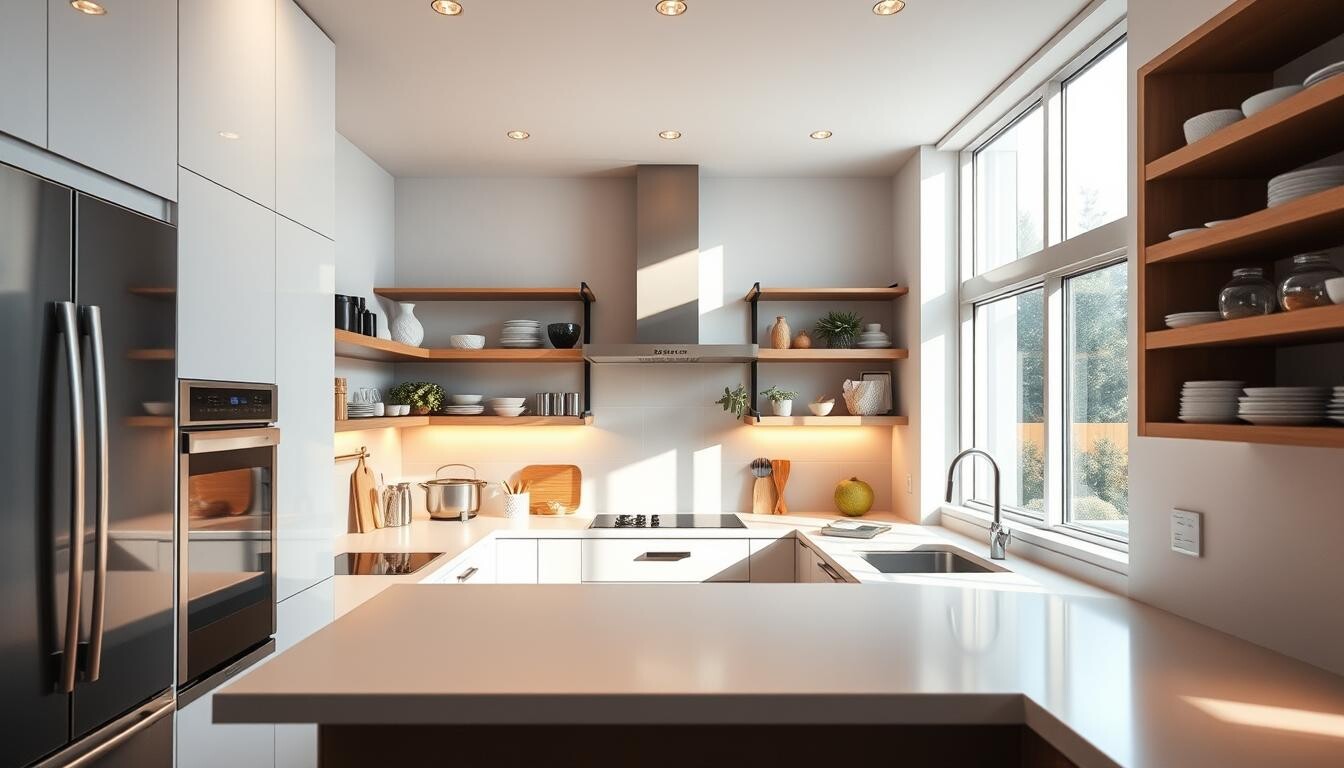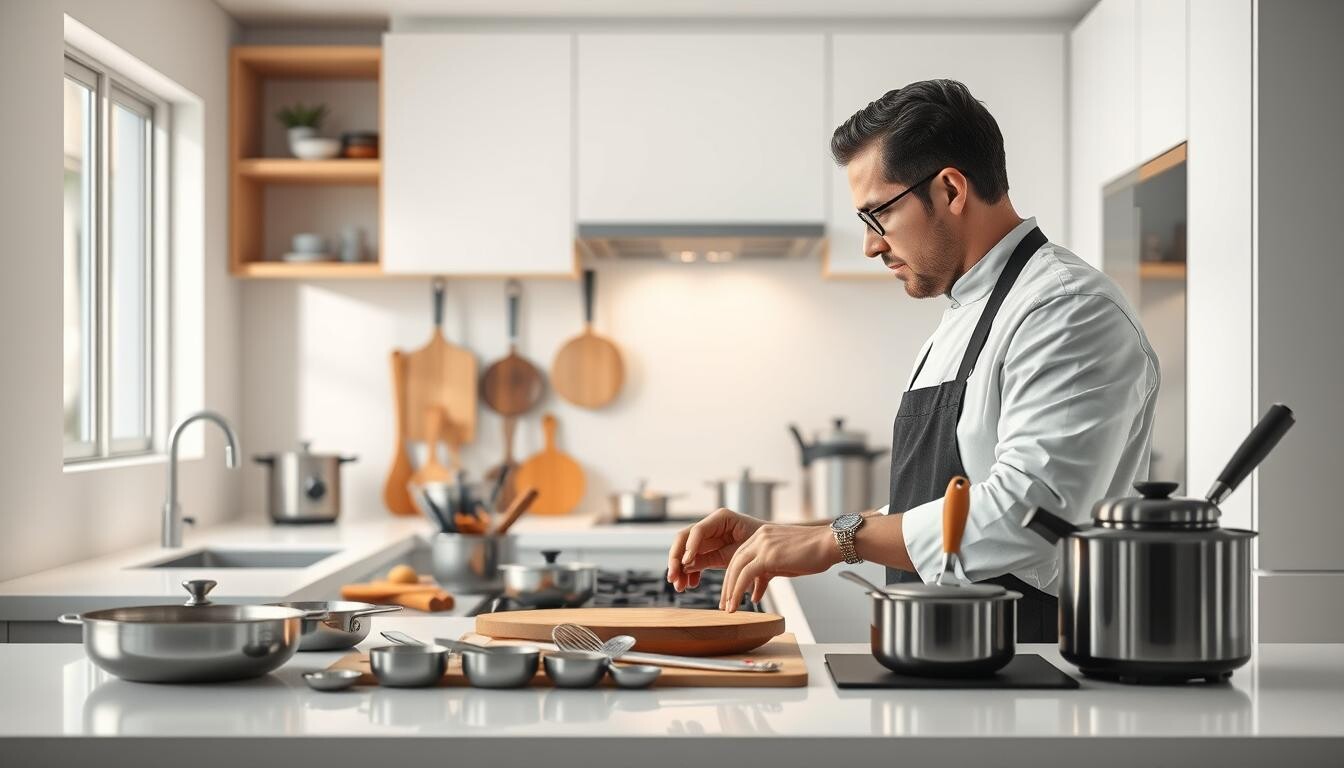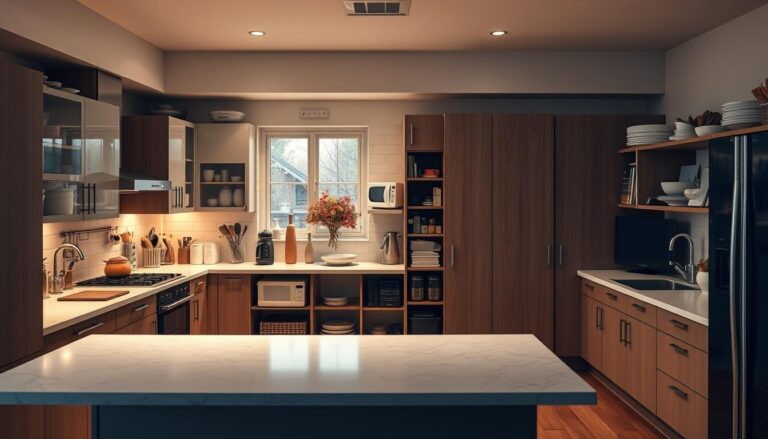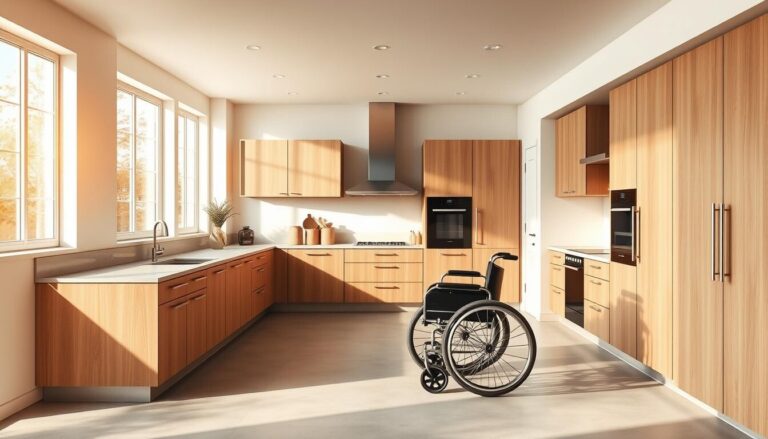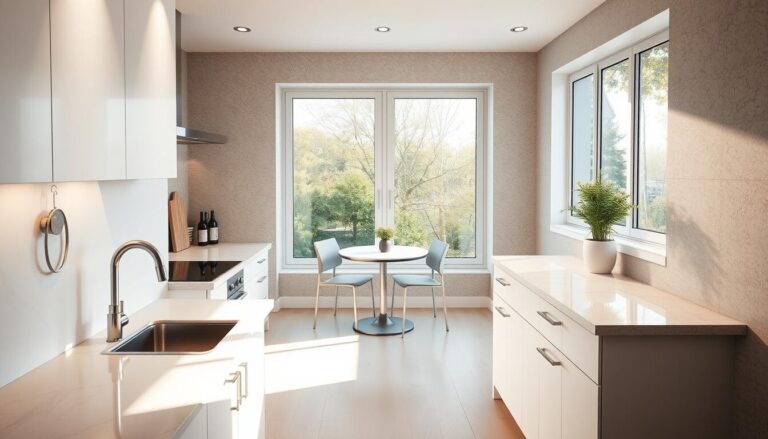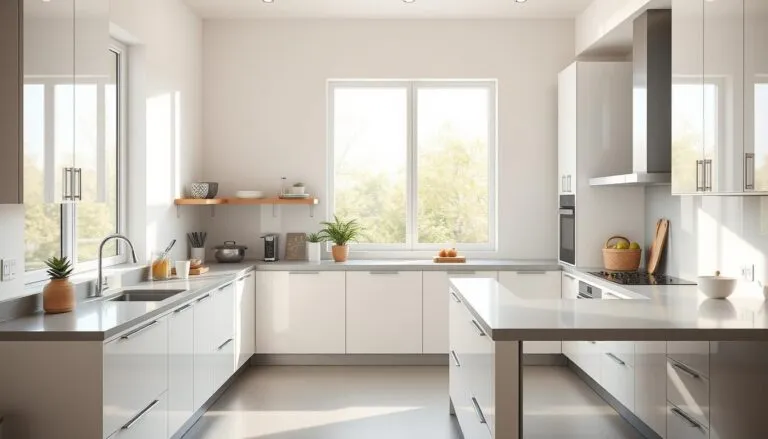Have you ever wondered why cooking feels exhausting even after a short time in the kitchen? The answer might lie in how your space is designed. A well-thought-out layout can make all the difference in reducing strain and boosting efficiency.
Just like in an office, the way you position items and tools in your kitchen impacts your comfort. For example, placing frequently used items within easy reach can save you countless steps and minimize unnecessary bending or stretching.
This article will guide you through the best practices for designing a kitchen that works for you. From optimizing your work areas to arranging equipment strategically, you’ll discover how small changes can lead to big improvements in your daily cooking experience.
Foundations of a Kitchen Built on Ergonomic Principles
Ever feel like your kitchen setup is working against you? The way your kitchen is organized can significantly impact your comfort and efficiency. By applying ergonomic principles, you can create a space that supports your body and enhances your cooking experience.

Why Ergonomics Matter in Your Kitchen
Think of your kitchen as a workspace. Just like in an office, poor design can lead to discomfort and even injury. A well-planned layout reduces strain on your arm and elbow, making tasks like chopping and stirring easier.
For example, placing frequently used items in a dedicated reach zone minimizes unnecessary movement. This keeps unnecessary steps gone and reduces the risk of repetitive strain. Studies show that kitchens designed with these principles can improve productivity by up to 25%.
“A kitchen designed with ergonomics in mind is not just about comfort—it’s about creating a healthier, more efficient space.”
The Health Benefits of a Well-Zoned Cooking Space
A well-organized kitchen isn’t just about convenience—it’s about your health. Proper countertop height allows your arm to rest at a 45-degree angle, reducing back and shoulder strain by 30%. Deep drawers instead of cabinets can cut bending and stretching by 50%.
Here’s a quick breakdown of how ergonomic design benefits you:
| Benefit | Impact |
|---|---|
| Reduced injury risk | Decreases repetitive strain by 50% |
| Improved productivity | Enhances cooking efficiency by 25% |
| Better posture | Reduces back pain by 35% |
| Enhanced accessibility | Cuts search time for tools by 15% |
By focusing on ergonomics, you can transform your kitchen into a space that supports your body and makes cooking more enjoyable. Small changes, like optimizing your reach zone, can lead to big improvements in your daily routine.
Designing a Functional Kitchen Layout for Enhanced Efficiency
Do you find yourself constantly moving back and forth in your kitchen while cooking? A well-planned layout can transform your cooking experience by minimizing unnecessary steps and maximizing efficiency. By focusing on natural movement patterns, you can create a space that works with you, not against you.
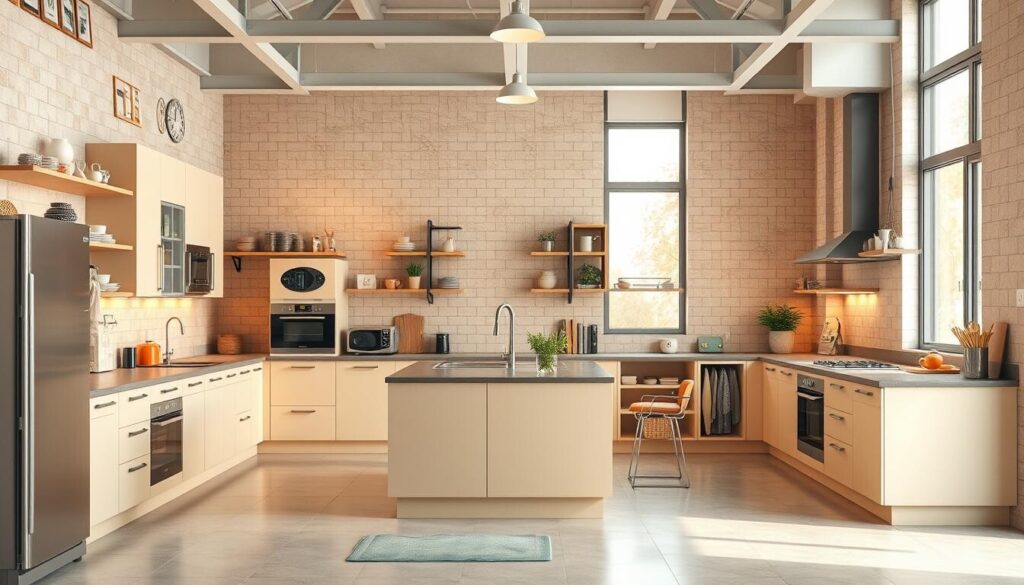
Understanding Work Flow and Movement
Your kitchen should mirror the way you naturally move during cooking. Think of it as a work zone where every step has a purpose. For example, placing the sink, stove, and fridge in a logical sequence reduces wasted movement. This approach ensures that your workflow is smooth and intuitive.
Studies show that kitchens designed with these principles can cut cooking time by up to 20%. By grouping items needed for specific tasks, you can minimize the distance between your equipment and your main working area. This not only saves time but also reduces physical strain.
“A kitchen designed for efficiency is like a well-oiled machine—every part works together seamlessly.”
Creating Comfortable Reach Zones in Your Cooking Area
Positioning frequently used items within easy reach is key to a functional kitchen. Just like in an office, your primary work zone should have everything you need immediately accessible. This includes utensils, spices, and small appliances.
Here’s how to optimize your reach zones:
- Place cutting boards and knives near the prep area.
- Store pots and pans close to the stove.
- Keep dishes and utensils near the dishwasher for easy unloading.
By organizing your kitchen today, you can reduce unnecessary bending and stretching. This not only enhances efficiency but also supports your body’s natural movement.
| Benefit | Impact |
|---|---|
| Reduced movement | Cuts cooking time by 20% |
| Improved accessibility | Minimizes physical strain |
| Enhanced workflow | Boosts overall efficiency |
By focusing on these strategies, you can create a kitchen that feels as efficient as a well-designed workstation. The right layout and storage solutions can make all the difference in your daily cooking routine.
Ergonomic Zones: Positioning Your Kitchen Equipment for Comfort
Is your kitchen setup causing unnecessary strain during meal prep? The way you position your appliances and tools can make a big difference in your comfort and efficiency. By aligning your kitchen with ergonomic working principles, you can reduce stress on your body and create a more enjoyable cooking experience.
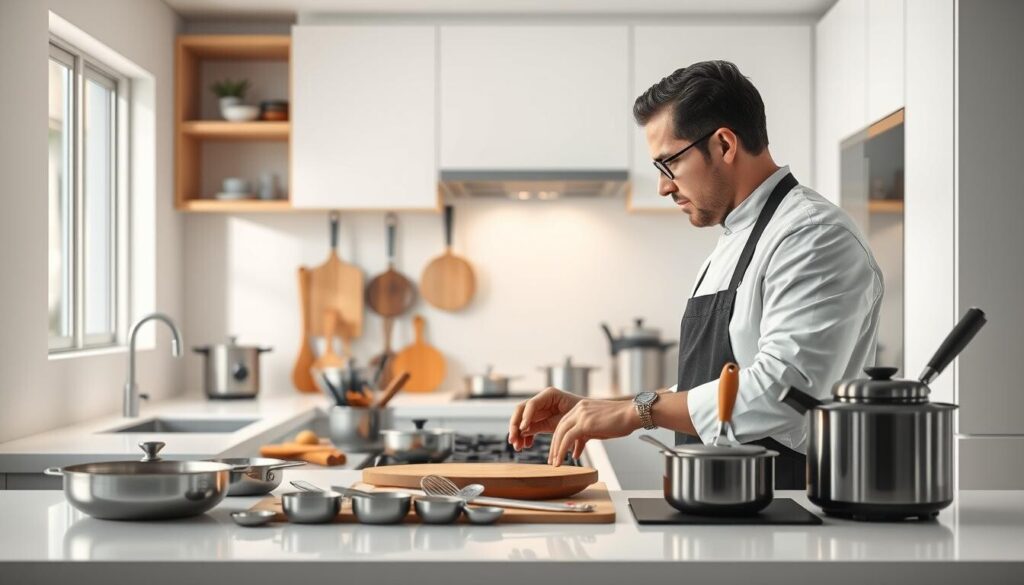
Optimal Placement of Appliances and Work Tools
Think of your kitchen as a workplace. Just like a well-organized workstation, your cooking area should have everything within easy reach. For example, place your stove, sink, and fridge in a logical sequence to minimize movement. This reduces unnecessary steps and keeps your workflow smooth.
Studies show that positioning frequently used items at a height of 85 to 95 centimeters can reduce back strain by up to 30%. Similarly, mounting your sink 10 to 15 centimeters higher than the countertop can make washing dishes easier on your posture.
Leveraging Storage Solutions and Clear Zones
Effective storage is key to maintaining a clutter-free kitchen. Use full-extension drawers to access items at the back of cabinets easily. This not only enhances organization but also reduces the need for bending and stretching.
Here’s how to create clear zones in your kitchen:
- Keep cutting boards and knives near the prep area.
- Store pots and pans close to the stove.
- Place dishes and utensils near the dishwasher for quick unloading.
| Benefit | Impact |
|---|---|
| Reduced movement | Cuts cooking time by 20% |
| Improved accessibility | Minimizes physical strain |
| Enhanced workflow | Boosts overall efficiency |
By organizing your kitchen like a desk, you can ensure that every tool is within reach. This not only makes meal prep easier but also promotes long-term health by minimizing awkward movements. A well-planned kitchen is a more pleasant and efficient workplace.
Practical Tips for a Healthier, More Organized Kitchen Environment
Does your kitchen feel cluttered and inefficient during meal prep? A well-organized cooking space can save you time, reduce risk of injury, and create a more enjoyable environment. By focusing on task-based arrangements and avoiding common mistakes, you can transform your kitchen into a functional and comfortable area.
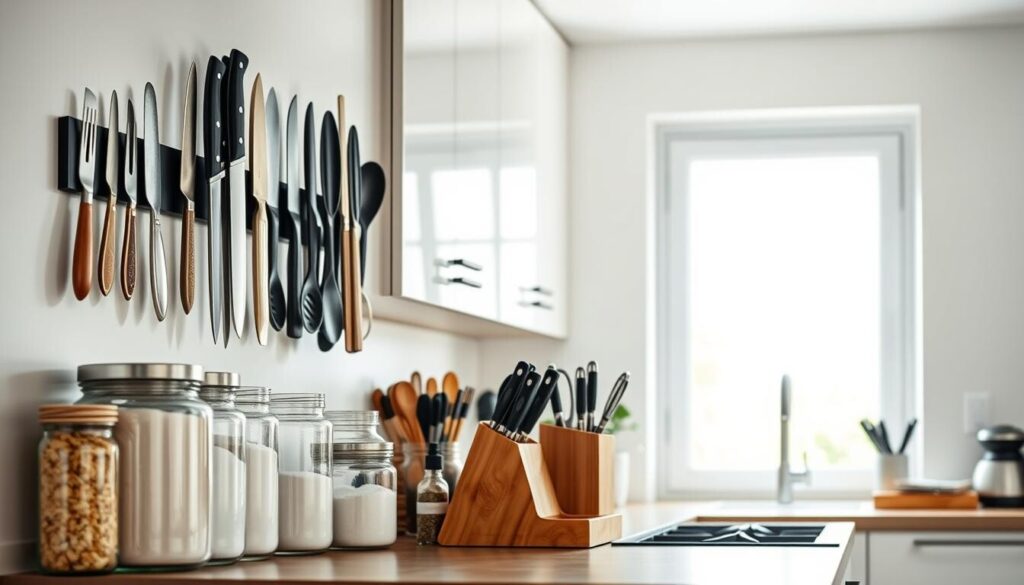
Task-Based Zone Arrangement and Adjustments
Start by dividing your kitchen into zones based on specific tasks. For example, create a prep area near the sink and a cooking zone close to the stove. This reduces unnecessary movement and keeps everything within easy access.
Here’s how to optimize your zones:
- Store frequently used utensils and ingredients in the main work space.
- Place items used less frequently in higher or lower cabinets.
- Regularly evaluate your layout and make adjustments as needed.
By organizing your kitchen this way, you’ll save time and reduce physical strain.
Avoiding Common Mistakes in Kitchen Design
One of the biggest mistakes is overreaching for items stored too far away. This increases the risk of injury and disrupts your workflow. Another common issue is cluttering the workspace with tools used less frequently.
Here are some practical practices to avoid these mistakes:
- Keep cutting boards and knives near the prep area.
- Store pots and pans close to the stove.
- Use pull-out shelves for easy access to items at the back of cabinets.
By following these tips, you’ll create a more efficient and healthier environment.
Small changes in practice can make a big difference. Regularly decluttering and optimizing your kitchen layout will reduce risk and improve your overall cooking experience. A well-organized kitchen is not just about convenience—it’s about creating a space that works for you.
Conclusion
Creating a kitchen that supports your health and efficiency is easier than you think. By organizing your space thoughtfully, you can reduce strain on your back and avoid discomfort when bending. This not only enhances your cooking experience but also prevents posture-related disorders.
This blog has highlighted the benefits of a well-planned kitchen. From optimizing your material placement to ensuring everything is within easy reach, small changes can make a big difference. A functional layout minimizes unnecessary movement and keeps your workflow smooth.
Take action today to transform your kitchen into a space that works for you. By following the tips shared here, you’ll create a more enjoyable and efficient cooking environment. Your health and productivity will thank you.


